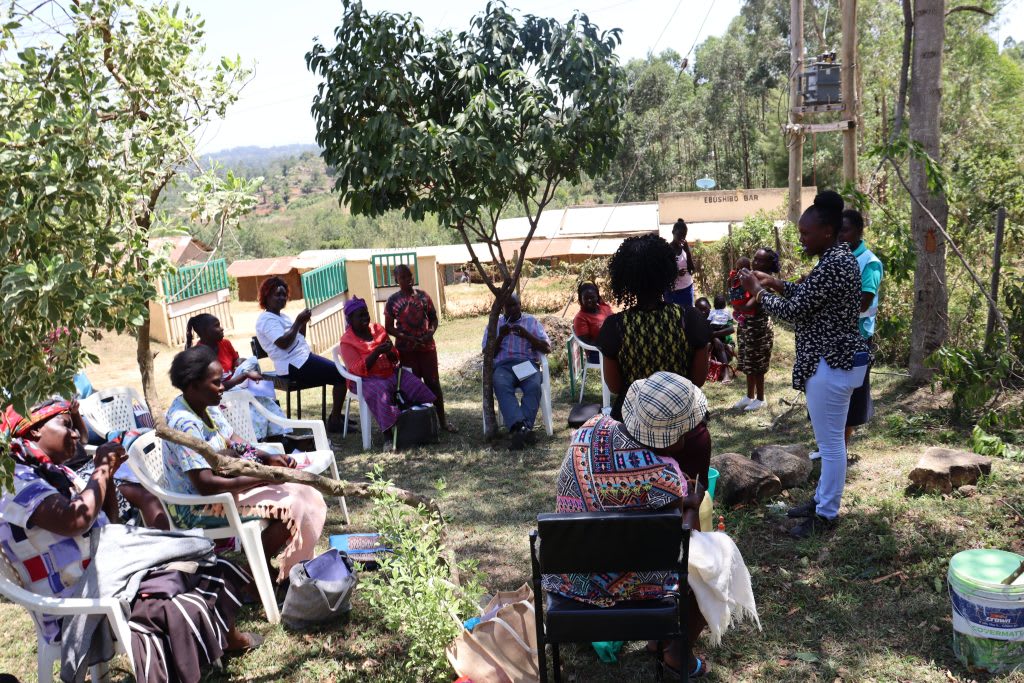The Shiyunzu Health Center provides vital medical services to the local community, treating an average of 50 outpatients daily. Despite facing the significant challenge of lacking access to a reliable and safe water source, the center continues to operate and serve its patients.

"Shiyunzu Dispensary (Health Center) was established in 2018 by the Ministry of Health in Kakamega County. Prior to its establishment, there were no nearby healthcare facilities, which forced community members to travel long distances to seek medical assistance," shared Field Officer Rachael Obura.
"The health care facility shares its water with community members. During the dry season, there is usually congestion at the waterpoint as people scramble for water, leading to conflicts," continued Rachael.

People waiting to collect water.
Normally, the center's rain tanks can barely meet their daily needs, especially when shared by the surrounding community. During the dry season, water is even more scarce and has to be rationed. The health center rain tanks must be reserved for the staff, and patients' use only, so local residents are forced to either purchase water from water vendors or make the labor-intensive journey to an alternative, unprotected water source themselves. This steals their resources—monetarily, physically, or time-wise—detracting from their ability to thrive and simply allowing them to survive.
Sadly, the water that community members work so hard to access is reported to have an unpleasant taste, smell, and appearance, which is not surprising considering it comes from contaminated sources.
"There have been high incidences of waterborne diseases, such as diarrhea and typhoid, among the nearby community members," shared Rachael. So not only are people's time and energy consumed, but the water they work so hard to obtain ends up making them ill and sending them to the health center for treatment.

Patrick.
"Clean and safe drinking water is paramount in any given household. As a community, we should all strive to have clean and safe drinking water. We all need water for our daily activities like cleaning, cooking, and bathing. Water keeps us hydrated," said 50-year-old farmer and local community member Patrick Nadwa.
Patrick wisely shared, "If action is not taken, waterborne diseases will take a toll on the community members, and it will affect their progress. Healthy community members are a wealthy community."

The center's pharmacy.
Access to clean water isn't just beneficial; it's crucial for the Shiyunzu Health Center's safe and effective operation. Water plays a multifaceted role in healthcare delivery, from maintaining hygiene standards to enabling proper sanitation practices. The broader benefits of clean water mean a community set to thrive. The absence of a reliable clean water source not only hampers the health center's ability to provide quality care but also perpetuates a cycle of health challenges within the broader population it serves. Implementing a well on campus will make an impact on the health center, making proper medical care an easier venture and creating a healthier community.
Steps Toward a Solution
Our technical experts worked with the local community to identify the most effective solution to their water crisis. They decided to drill a borehole well, construct a platform for the well, and attach a hand pump.
Well
Abundant water often lies just beneath our feet. Aquifers—natural underground rivers—flow through layers of sediment and rock, offering a constant supply of safe water. A borehole well is drilled deep into the earth to access this naturally filtered and protected water. We penetrate meters, sometimes even hundreds of meters, of soil, silt, rock, and more to reach the water underground. Once found, we construct a platform for the well and attach a hand pump. The community gains a safe, enclosed water source capable of providing approximately five gallons of water per minute. Learn more here!
Handwashing Stations
Alongside each water source, we install handwashing stations at points of care and at the latrines, enabling everyone at the health center to wash their hands. Handwashing is crucial for preventing water-related illnesses within the health center and community. Health center staff will maintain the stations, fill them with water, and supply them with soap, which we will teach them how to make.
Latrines
We ensure there are Ventilated Improved Pit (VIP) latrine blocks that effectively prevent the transmission of fecal diseases. Each latrine will boast a durable cement floor for easy use and maintenance. We’ll ensure at least one stall is reserved for staff, along with gender-separated toilets that include menstrual hygiene facilities and accessible options for individuals with limited mobility.
Health Center Education & Ownership
Hygiene and sanitation training are integral to our water projects. Training is tailored to each health center's specific needs and includes key topics such as proper water handling, improved hygiene practices, disease transmission prevention, and care of the new water point. Encouraged and supported by the guidance of our team, a water user committee comprises a community health volunteer, the staff in charge of the clinic, a community leader, and the health center board representative. They assume responsibility for maintaining the waterpoint, promoting safe hygiene and sanitation practices, and keeping handwashing stations well-stocked.
Safe water and improved hygiene habits foster a healthier future for everyone in the community.

 Borehole Well and Hand Pump
Borehole Well and Hand Pump































